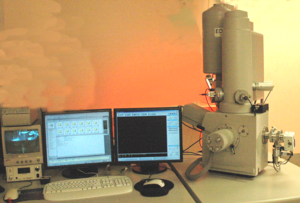Difference between revisions of "Scanning Electron Microscope"
Cmditradmin (talk | contribs) m (→Significance) |
Cmditradmin (talk | contribs) m |
||
| Line 8: | Line 8: | ||
=== Overview === | === Overview === | ||
[[Image:Sirion_sem.png|thumb|300px|]] | [[Image:Sirion_sem.png|thumb|300px|]] | ||
The scanning electron microscope is used to image the surface of a conducting sample by scanning it with a high energy beam of electrons. | The scanning electron microscope is used to image the surface of a conducting sample by scanning it with a high energy beam of electrons. The SEM is a useful tool for photonics research because it reveals nano-scale surface features and topography that is critical to the performance of multi-layer devices. SEM produces dramatic pictures that reveal 3D shapes and shadows. | ||
=== Significance === | === Significance === | ||
Some SEMs have additional software enhancements than enable them to focus the beam on a photomask for [[E-beam lithography]] or are equipped for focused ion beam (FIB) milling. SEM can be equipped with attachments so it be used for elemental analysis using Energy Disspersive X-ray spectroscopy EDAX. | |||
=== Operation === | === Operation === | ||
Part 1 Tour and Sample Preparation | Part 1 Tour and Sample Preparation | ||
Revision as of 08:02, 3 November 2011
| Return to Research Tool Menu |
Overview
The scanning electron microscope is used to image the surface of a conducting sample by scanning it with a high energy beam of electrons. The SEM is a useful tool for photonics research because it reveals nano-scale surface features and topography that is critical to the performance of multi-layer devices. SEM produces dramatic pictures that reveal 3D shapes and shadows.
Significance
Some SEMs have additional software enhancements than enable them to focus the beam on a photomask for E-beam lithography or are equipped for focused ion beam (FIB) milling. SEM can be equipped with attachments so it be used for elemental analysis using Energy Disspersive X-ray spectroscopy EDAX.
Operation
Part 1 Tour and Sample Preparation
Part 2 Loading the Sample
Part 3 Setting the Working Distance
Part 4 Lens Alignment and Stigmation
Part 5 Moving the Stage and Imaging
Part 6 Changing the Sample and Shutdown
